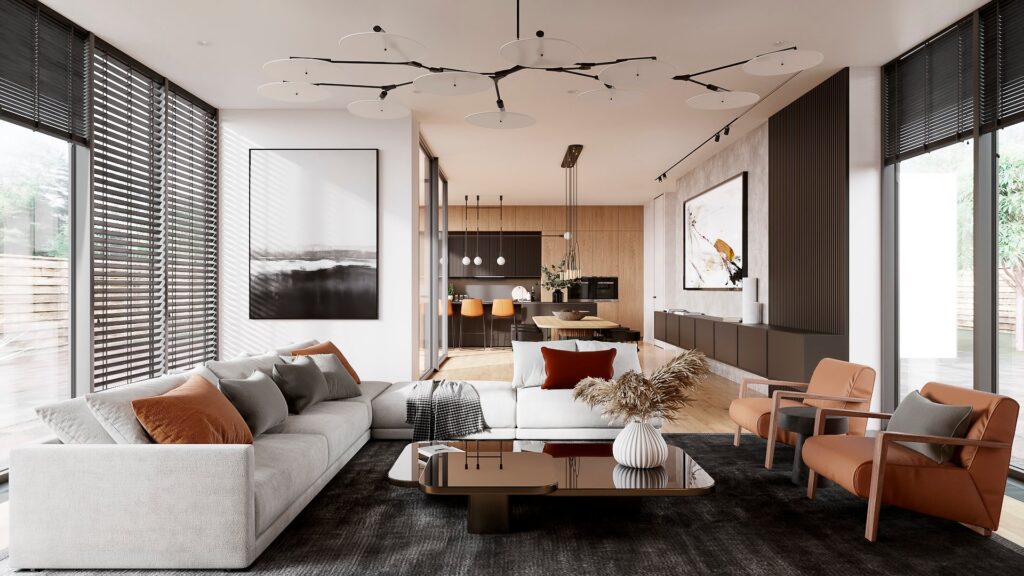Do you ever feel lost when designing or renovating your living room? Need help deciding which furniture to choose, what colors to paint the walls, or how to arrange everything for that perfect look and feel? It’s a common dilemma. But what if there was a magical tool that could guide you through this maze of decisions?
Enter CGI (computer-generated imagery), a ground-breaking technology changing the game in lifestyle and interior design. This tool lets you conceptualize, design, experiment, and visualize your dream living room digitally, even before buying or rearranging a single item.
CGI, or computer-generated imagery, involves the use of computer software to create realistic and immersive digital representations of objects and environments or visual effects, often in the form of images and animations. This article will show you how CGI can change your living room experience.
CGI Allows Living Space Customization
Historically, CGI has primarily been utilized in the film and video game industries to craft captivating visual effects. However, this technology is now moving beyond entertainment and is making waves in the field of lifestyle and interior design.
This tech is now a creative tool for everyday homeowners and designers. You can use CGI to create different design options and layouts for your living room and see how they look before you buy or renovate anything. Here are some ways that CGI can help you customize your living room:
Visualize Design Options
One significant advantage of CGI is the ability to easily visualize and experiment with different design options for a living space. Homeowners and interior designers can work with a CGI studio to digitally mock up their existing room and then virtually try out new furniture arrangements, lighting fixtures, flooring patterns, and more without buying or installing anything. You can also compare options and choose the best one for your budget and taste. This allows you to perfect a design visually before purchasing.
See Products in Augmented Reality
Innovative apps can take CGI even further by showing true-to-life 3D renderings of products in augmented reality right in your living room. Home decor and furniture retailers offer apps where you can digitally overlay furniture and decor onto your existing space to preview products to scale in your home before you buy.
Match Artwork and Fabrics to Style
Suppose you want to add some personal touches to your living room. In that case, you can use CGI to create custom art, wallpapers, fabrics, and other decorative items that match your style. You can work with a CGI studio to create unique and original artworks, wallpapers, posters, etc., that reflect your personality and interests. You can also use CGI to create custom fabrics, cushions, curtains, rugs, etc., that match your living room’s color scheme and theme.
Simulate Finishes and Lighting
Finally, CGI allows for easy experimentation with different finishes and lighting setups. Create different lighting scenarios for your living room, such as natural, artificial, dim, etc. You can also use CGI to create different floors for your living room, such as hardwood, carpet, tile, etc. The right CGI studio can simulate any design combinations you can imagine.

Photographer: Amr Taha
CGI for Conceptual Creative Spaces
CGI tools have become integral for architects and designers to let their creativity run free when conceptualizing new living spaces that defy design limitations.
No Physical Limitations
When designing in a digital CGI environment, architects aren’t constrained by the physical and structural limitations of actually building a room. They can experiment with unconventional shapes, impossible gravity-defying arrangements, and expensive or rare materials that wouldn’t be feasible in the real world.
Interactive and Dynamic Elements
CGI also allows architects to integrate interactive and dynamic elements into their conceptual spaces. They can add advanced technologies like virtual assistants, smart home devices, 3D hologram projectors, and more to create a vision of a truly technologically-integrated living room.
Simulate Environments
Another advantage of CGI is the ability to simulate different environments and ambiances within a digital living room. Architects can experiment with different lighting at various times of day, weather patterns, seasons, and other environmental conditions to set a mood or test how a space might feel in actual occupational use.
Inspires Real World Designs
Though conceptual, these CGI environments create inspiration and ideas that influence real-world living space design. Newly constructed living rooms integrate more technology, unconventional layouts, and interactive features as CGI pushes creativity and innovation further.
Immersive Entertainment Through CGI
Home entertainment is another area where CGI enhances realism and immersion, transforming living rooms into unbelievable new interactive worlds.
Virtual Reality Living Rooms
Imagine donning a virtual reality headset and being transported to a living room with wall-to-ceiling screens and holograms surrounding you. CGI can create hyperrealistic virtual living rooms where you’re immersed in movies, sports, video games, and any digital media.
Living Room Theaters
Similar CGI technology can convert a living room into a lifelike cinema theater environment. Projectors and surround sound can simulate a movie theater auditorium with large screens and theater seating in your home.
Transported into Scenes
These virtual CGI environments transcend passive viewing by transporting you directly into video game scenes, live concerts, exotic travel locations, or whatever experience designers can imagine. It’s an engaging world of endless possibilities.
Customized Entertainment
The interactivity also allows for customized entertainment. You may choose different CGI living room environments tailored to your desired mood. And environments can dynamically react and change based on your preferences.
Realistic CGI Materials and Textures
Recent advancements in CGI technology have made it possible to create highly realistic digital representations of various materials, such as wood, stone, fabric, glass, vegetation, and lighting fixtures. These CGI tools can mimic the appearance and texture of these materials with impressive precision.
As a result, when using CGI in the design process for living rooms, it becomes easier for you to imagine how your conceptual designs will look and feel in reality. For instance, you can better envision the warmth of wooden floors or the comfort a textured area rug will provide.
For architects and designers, virtually trying out different materials and finishes allows for faster iteration and experimentation without physical building. They can digitally tweak metals, wood, wall textures, and lighting fixtures to refine designs.
The lifelike CGI visuals give clients and collaborators an impression of walking through a real living space rather than flat conceptual drawings. CGI brings digital designs to life.
Conclusion
Once merely a tool for cinematic fantasies, CGI brings imaginative and customized living spaces into reality. Through conceptual designs unbounded by physical constraints along with virtual and augmented environments, CGI living rooms allow homeowners to transcend the ordinary. This technology will continue opening new creative possibilities to make our personalized living spaces more immersive, interactive, and visually stunning than ever thought achievable.






